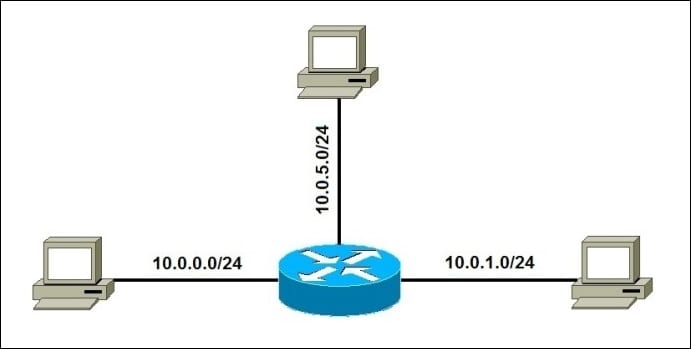EIGRP is not explicitly listed in the latest 200-301 version of the CCNA exam topics (whereas OSPF is) but you can still be tested on it in the exam.
The network command in EIGRP uses a classful network as the parameter by default, which means that all interfaces inside the classful network will participate in the EIGRP process. We can enable EIGRP only for specific networks using wildcard masks. The syntax of the command is:
(router-eigrp)#network IP_ADDRESS WILDCARD_MASK
We will use the following example network:
The router is directly connected to three subnets. Let’s say that we want to advertise only the 10.0.0.0/24 subnet in EIGRP. We can use the wildcard mask of 0.0.0.255 to do this:
R1(config-router)#network 10.0.0.0 0.0.0.255
Using the show ip protocols command we can verify that only the subnet 10.0.0.0/24 is included in EIGRP:
R1#show ip protocols Routing Protocol is "eigrp 1 " Outgoing update filter list for all interfaces is not set Incoming update filter list for all interfaces is not set Default networks flagged in outgoing updates Default networks accepted from incoming updates EIGRP metric weight K1=1, K2=0, K3=1, K4=0, K5=0 EIGRP maximum hopcount 100 EIGRP maximum metric variance 1 Redistributing: eigrp 1 Automatic network summarization is in effect Automatic address summarization: Maximum path: 4 Routing for Networks: 10.0.0.0/24 Routing Information Sources: Gateway Distance Last Update Distance: internal 90 external 170
Notice that 10.0.0.0/24 is listed under the Routing for Networks column. The other two networks (10.0.1.0/24 and 10.0.5.0/24) are not included in EIGRP.
Download our Free CCNA Study Guide PDF for complete notes on all the CCNA 200-301 exam topics in one book.
We recommend the Cisco CCNA Gold Bootcamp as your main CCNA training course. It’s the highest rated Cisco course online with an average rating of 4.8 from over 30,000 public reviews and is the gold standard in CCNA training:

